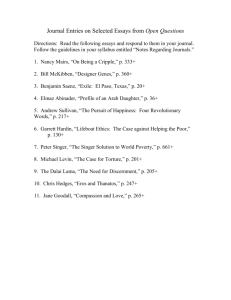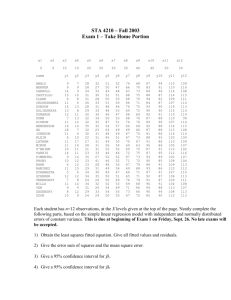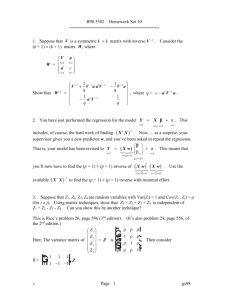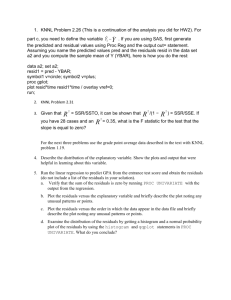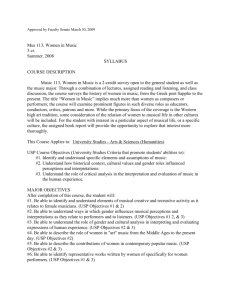Residual analysis for linear mixed models - IME-USP
advertisement
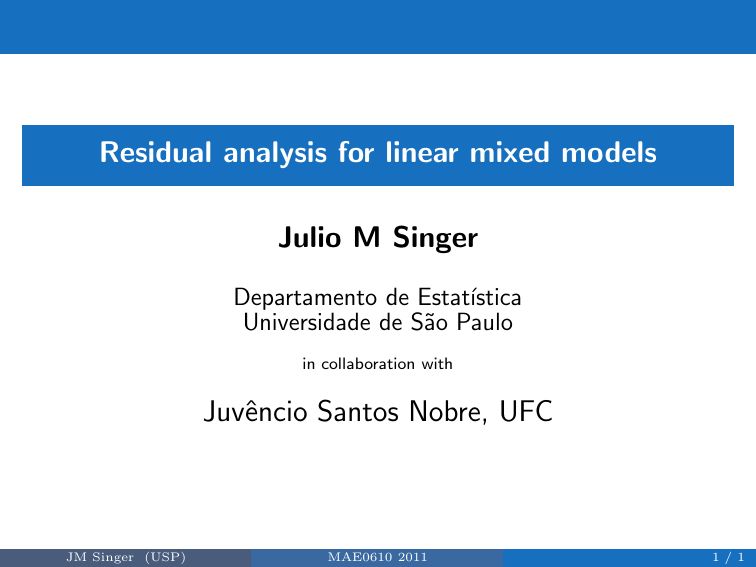
Residual analysis for linear mixed models
Julio M Singer
Departamento de Estatı́stica
Universidade de São Paulo
in collaboration with
Juvêncio Santos Nobre, UFC
JM Singer (USP)
MAE0610 2011
1 / 1
Example of repeated measures
Study conducted at the School of Dentistry of the University of São
Paulo
Objective: compare the effect of an experimental toothbrush with
that of a conventional one with respect to bacterial plaque reduction
Design: bacterial plaque index measured on 32 pre-schoolers (16 with
conventional and 16 with experimental toothbrush) before and after
toothbrushing in 4 sessions spaced by 15 days
Repeated measures: same characteristic measured on each subject
more than once
Observations on each subject tend to be correlated
JM Singer (USP)
MAE0610 2011
2 / 1
The data
Table 1: Bacterial plaque indices
Subject
1
2
3
..
.
Toothbrush
conventional
conventional
experimental
..
.
29
30
31
32
conventional
experimental
experimental
conventional
JM Singer (USP)
1st session
Before
After
brushing brushing
1.05
1.00
1.07
0.62
0.82
0.62
..
.
...
0.91
1.06
2.30
1.15
0.67
0.70
2.00
1.00
MAE0610 2011
...
...
...
...
...
...
..
.
...
...
...
...
4th session
Before
After
brushing brushing
1.13
0.94
1.15
0.85
1.78
1.39
..
.
1.12
1.12
2.15
1.26
0.37
1.00
1.90
1.00
3 / 1
Approaches for analysis of repeated measures
Multivariate Analysis
Balanced data (all subjects measured at the same occasions)
Many covariance parameters
Exact inference based on normality assumption
Generalized Estimating Equations
Interest in marginal response
Covariance structure based on working covariance matrix
Unspecified underlying distribution (except for first two moments)
Random Effects Models
Models for the covariance structure
Marginal and subject-specific inference
Some flexibility in the form of underlying distributions
Alencar, Singer and Rocha (2010, submitted) compare different
approaches
JM Singer (USP)
MAE0610 2011
4 / 1
Linear mixed models
Linear mixed models: popular alternative to analyze repeated measures
and, in particular, longitudinal data.
yi = Xi β + Zi bi + ei , i = 1, ..., m,
where
yi : (ni × 1) vector of response variables measured on subject i
β: (p × 1) vector of parameters (fixed effects)
Xi and Zi : (ni × p) and (ni × q) known matrices of full rank
bi : (q × 1) random vector, the components of which are called
random effects
ei : (ni × 1) random (within-subject) error term
JM Singer (USP)
MAE0610 2011
5 / 1
Linear mixed models
Usually one assumes
iid
bi ∼ Nq (0, G) i = 1, ..., m
ind
ei ∼ Nni (0, Σi )
bi and ei independent
G and Σi are (q × q) and (ni × ni ) positive definite matrices with
elements expressed as functions of a vector of covariance parameters
θ not functionally related to β
If Σi = Ini σ 2 : homoskedastic conditional independence model
JM Singer (USP)
MAE0610 2011
6 / 1
BLUE and BLUP
Letting
⊤ ⊤
y = (y1⊤ , · · · , ym
) ,
⊤ ⊤
X = (X⊤
1 , · · · , Xm ) ,
⊤ ⊤
b = (b⊤
1 , · · · , bm ) ,
Γ = Im ⊗ G,
Z = ⊕m
i=1 Zi
⊤ ⊤
e = (e⊤
1 , · · · , em )
Σ = ⊕m
i=1 Σi
we can write the model more compactly as
y = Xβ + Zb + e
Given Γ and Σ
Best Linear Unbiased Estimator (BLUE) of β :
Best Linear Unbiased Predictor (BLUP) of b :
with
b = Ty
β
b
b = ΓZ⊤ Qy
−1 ⊤
T = X⊤ MX
X M
Q = M(I − XT)
M = V−1 = (ZΓZ⊤ + Σ)−1
JM Singer (USP)
MAE0610 2011
7 / 1
Estimation of covariance parameters
Most popular methods for estimation of covariance parameters in θ
and consequently in Γ and Σ
maximum likelihood
restricted maximum likelihood (REML)
b and b
b with convenient
Replacing Γ and Σ in the expressions for β
estimates leads to the so called empirical BLUE (EBLUE) and
empirical BLUP (EBLUP)
Other estimation methods for the parameters of linear mixed models
discussed in Searle et al. (1992, Wiley) and Demidenko (2004, Wiley)
JM Singer (USP)
MAE0610 2011
8 / 1
Trellis display for the example data
1.0
1st session
Conventional toothbrush
1.5
2.0
1st session
Monoblock toothbrush
2.0
1.5
Posttreatment bacterial plaque index
1.0
0.5
2nd session
Conventional toothbrush
2nd session
Monoblock toothbrush
3rd session
Conventional toothbrush
3rd session
Monoblock toothbrush
2.0
1.5
1.0
0.5
2.0
1.5
1.0
0.5
4th session
Conventional toothbrush
4th session
Monoblock toothbrush
2.0
1.5
1.0
0.5
1.0
1.5
2.0
Pretreatment bacterial plaque index
JM Singer (USP)
MAE0610 2011
9 / 1
Linear mixed model for the example
Based on Singer et al. (2004, Statistical Modelling) who analyze a
different data set from the same study, we considered fitting models of the
form
ln yijd = αjd + βjd ln xijd + bi + eijd ,
(1)
where
yijd (xijd ) is the posttreatment (pretreatment) bacterial plaque index
for the i-th subject evaluated in the d-th session with the j-th type of
toothbrush (j = 0: conventional)
αjd is a effect associated to the j-th toothbrush type in the d-th
session
βjd is a coefficient of uniformity of the expected bacterial plaque
index reduction rate associated to the j-th toothbrush type in the
d-th session
bi ∼ N(0, τ 2 ) and eijd ∼ N(0, σ 2 ) are independent
JM Singer (USP)
MAE0610 2011
10 / 1
Analysis strategy
i) Test whether uniformity coefficients are homogeneous for the two
types of toothbrush across the four sessions, i.e., whether βjd = β,
j = 0, 1, d = 1, ..., 4
ii) Test whether main effect of type of toothbrush and interaction
between type of toothbrush and evaluation session regarding the
coefficients of residual bacterial plaque index are null, i.e.,
α01 − α11 = α02 − α12 = α03 − α13 = α04 − α14
αjd = αj , d = 1, 2, 3, 4, j = 0, 1
iii) Fit model that incorporates the conclusions in (i) and (ii), i.e.,
ln yijd = αj + β ln xijd + bi + eijd
JM Singer (USP)
MAE0610 2011
11 / 1
Results
i) Model ln yijd = αj + β ln xijd + bi + eijd has a good fit when
compared with saturated model
ii) Maximum likelihood estimates and standard errors are
αˆ0 = −0.32 ± 0.03,
αˆ1 = −0.21 ± 0.03,
τ̂ 2 = 0.006 ± 0.0028,
β̂ = 1.06 ± 0.06
σ̂ 2 = 0.021 ± 0.002
Essentially, the results indicate that
a) The expected reduction in the bacterial plaque index lies around 27%
for the conventional toothbrush compared to 19% for the
experimental one
b) There is no reduction in efficiency for either toothbrush within the
investigation period
JM Singer (USP)
MAE0610 2011
12 / 1
Residual Analysis
Residuals frequently used to
evaluate validity of assumptions of statistical models
help in model selection
For standard (normal) linear models, residuals are used to verify
homoskedasticity
linearity of effects
presence of outliers
normality and independence of the errors
JM Singer (USP)
MAE0610 2011
13 / 1
Type of residuals in linear mixed models
Cox and Snell (1968, JRSS-B): general definition of residuals for
models with single source of variability
Hilden-Minton (1995, PhD thesis UCLA), Verbeke and Lesaffre
(1997, CSDA) or Pinheiro and Bates (2000, Springer): extension to
define three types of residuals that accommodate the extra source of
variability present in linear mixed models, namely:
b=M
c −1 Qy,
b predictors of marginal
i) Marginal residuals, b
ξ = y − Xβ
errors, ξ = y − E[y] = y − Xβ = Zb + e
b − Zb
b=Σ
b Qy,
b predictors of
ii) Conditional residuals, b
e = y − Xβ
conditional errors e = y − E[y|b] = y − Xβ − Zb
b predictors of random effects, Zb = E[y|b] − E[y]
iii) BLUP, Zb,
JM Singer (USP)
MAE0610 2011
14 / 1
Confounded Residuals
Hilden-Minton (1995, PhD thesis, UCLA): residual is pure for a
specific type of error if it depends only on the fixed components and
on the error that it is supposed to predict
Residuals that depend on other types of errors are called confounded
residuals
Given that
b
c −1 X⊤ M]ξ,
c
ξ = [I − X(X⊤ MX)
b Qe
b +Σ
b QZb,
b
b
e = Σ
b = ZΓZ
b ⊤ QZb
b
b ⊤ Qe,
b
Zb
+ ZΓZ
we have
b
e is confounded with b
b is confounded with e
Zb
JM Singer (USP)
MAE0610 2011
15 / 1
Marginal Residuals
Since y = Xβ + ξ, plots of the marginal residuals (b
ξ) versus
explanatory variables may be employed to check linearity of y with
respect to such variables
b −1/2 b
Lesaffre and Verbeke (1998, Biometrics): Ri = V
ξ i are residuals
i
to check appropriateness of the within-subjects covariance matrix
2
When ||Ini − Ri R⊤
i || is small, within-subjects covariance matrix is
acceptable
JM Singer (USP)
MAE0610 2011
16 / 1
Marginal Residuals: example
Marginal residuals (a) and residuals for the within-subjects covariance
matrix structure (b)
12.2
-1.0
29.4
-0.4
-0.2
0.0
0.2
0.4
0.6
0.8
25
29
10
15
20
12
5
Residuals for the covariance matrix structure
0.5
0.0
Marginal residual
-0.5
29.3
30
(b)
1.0
(a)
0
Logarithm of the preteatment bacterial plaque index
5
10
15
20
25
30
Subject
Some indications that linearity and/or within-subjects covariance structure
might not be appropriate for subjects 12 and 29
JM Singer (USP)
MAE0610 2011
17 / 1
Conditional Residuals
Identification of outlying observations/subjects
Conditional standardized residuals (Nobre and Singer, 2007,
Biometrical Journal)
b
ek
b
e∗k = p
σ
b pbkk
pkk : k-th element of the main diagonal of ΣQΣ, k = 1, . . . , n
pbkk : functions of the joint leverage of the fixed and random effects
(Nobre and Singer, 2010, Journal of Applied Statistics)
b
e∗k : generalization of usual studentized residuals
JM Singer (USP)
MAE0610 2011
18 / 1
Conditional Residuals
Check homoskedasticity of conditional errors (Σ = σ 2 In ): plot
standardized conditional residuals versus fitted values
Check normality of conditional errors
Keep in mind the confounding present in b
e
Hilden-Minton (1995, PhD thesis, UCLA): ability to check for
normality of e, using ê, decreases as V[ΣQZ⊤ b] = ΣQZΓZ⊤ QΣ
increases in relation to V[ΣQe] = ΣQΣQΣ
Fraction of confounding for the k-th conditional residual b
ek
0 ≤ Fk =
⊤
u⊤
u⊤
k ΣQZΓZ QΣuk
k ΣQΣQΣuk
=
1
−
≤1
u⊤
ΣQΣu
u⊤
k
k
k ΣQΣuk
Least confounded residual linear transformation t⊤ b
e such that
λi =
t⊤
i ΣQΣQΣti
t⊤
i ΣQΣti
is maximum
JM Singer (USP)
MAE0610 2011
19 / 1
Least Confounded Residuals: example
Least confounded residuals: homoskedastic and uncorrelated with
variance σ 2
Check normality of the conditional errors via normal quantile plots
with simulated envelopes
Figure 3: Standardized conditional residuals (a) and simulated 95% confidence
envelope for the standardized least confounded conditional residuals (b)
(b)
2
0
-2
Least confounded residual
4
2
0
-2
-4
29.4
12.2
-4
Standardized conditional residual
4
(a)
0
5
10
15
20
25
30
-2
JM Singer (USP)
-1
0
1
2
Quantiles of N(0,1)
Subject
MAE0610 2011
20 / 1
EBLUP
EBLUP: reflects the difference between the predicted responses for
the i-th subject and the population average
V
b ⊤ { b [b
b i − bi ]}−1 b
bi
Useful to detect outlying subjects: plot ζbi = b
i
versus subject indices
Useful to assess which subjects are sensitive to homogeneity of the
covariance matrices of the random effects
Pinheiro and Bates (2000, Springer): scatter plot matrix of the
predicted random effects
Nobre (2004, MSc dissertation, USP): perturbation of the covariance
matrix of the i-th random effect by letting V[bi ] = wi G and
identifying subjects which are sensitive to this perturbation via local
influence methods
JM Singer (USP)
MAE0610 2011
21 / 1
EBLUP
Useful to check normality of random effects
Lange and Ryan (1989, Annals of Statistics): weighted normal quantile
plots of standardized linear combinations of the random effects
Jiang (2001, Annals of Statistics): test to check the assumption that
the distributions of b and e are as specified
Both papers rely on asymptotic arguments
Butler and Louis (1992, Statistics in Medicine): BLUE is not affected
by incorrect specification of distribution of b (simulation study)
Result confirmed theoretically by Verbeke and Lesaffre (1997, CSDA)
when distribution of b has finite third absolute moment, and only
requires a correction in the covariance matrix of the fixed effects
estimators
JM Singer (USP)
MAE0610 2011
22 / 1
EBLUP: example
Figure 4: EBLUP (a) and Cook’s |dmax | for the perturbed variance of
random effects (b)
(a)
0.3
1.0
(b)
0.6
|dmax|
0.4
0.0
0.2
-0.1
-0.2
29
0.0
-0.3
EBLUP
0.1
0.8
0.2
29
0
5
10
15
20
25
30
0
Subject
JM Singer (USP)
5
10
15
20
25
30
Subject
MAE0610 2011
23 / 1
Diagnostic results
Figure 2(b): Fitted covariance matrix may not be adequate for
subjects #12 and #29
Figure 3(a): Observations #12.2 and #29.4 are highlighted as
atypical with respect to the remaining standardized conditional
residuals: possible outliers
Figure 3(b): No observations outside the simulated envelope and do
not show trends: plausibility of the normality assumption for the
conditional error
Figure 4(a): subject #29 may be an outlier
Figure 4(b): data for subject # 29 not compatible with assumption of
homogeneity of variance of the random effects
JM Singer (USP)
MAE0610 2011
24 / 1
Summary
Table 2: Uses of residuals for diagnostic purposes
Diagnostic for
Linearity of effects ( [y] = Xβ)
Within-subjects covariance matrix (Vi )
Presence of outlying observations
Homoskedasticity of conditional errors (ei )
Normality of conditional errors (ei )
Presence of outlying subjects
Random effects covariance structure (G)
Normality of the random effects (bi )
E
JM Singer (USP)
Residual
Marginal
Marginal
Conditional
Conditional
Conditional
EBLUP
EBLUP
EBLUP
MAE0610 2011
Plot
ξbk vs explanatory variables
2
||Ini − Ri R⊤
i || vs subjects
∗
b
ek vs. observations
b
e∗k vs. fitted values
QQ least confounded resid
b i ) vs subjects
ζ̂i (or b
|dmax | vs. subjects
bi
Weighted QQ for b
25 / 1
Relative changes of estimates without outliers
Table 3: Estimates (± estimated standard errors) of parameters and
relative change with and without subjects #12 and #29
α0
-0.32±0.03
α1
-0.21±0.03
β
1.06±0.06
τ2
0.0063±0.0028
σ2
0.021±0.02
-0.32±0.03
(0.0%)
-0.22±0.03
(-4.8%)
1.06±0.06
(0.0%)
0.0069±0.0027
(-9.0%)
0.015±0.02
(28.6%)
- Sub #29
-0.33±0.03
(0.0%)
-0.19±0.03
(9.5%)
1.07±0.05
(0.9%)
0.0015±0.0013
(76.7%)
0.017±0.02
(-19.1%)
- Both
-0.32±0.03
(0.0%)
-0.19±0.03
(9.5%)
1.07±0.05
(0.9%)
0.0030±0.0014
(52.8%)
0.012±0.01
(42.9%)
Parameters
Complete
data
- Sub.#12
Details for influential subjects given in Nobre and Singer (2007, Biometrical
Journal)
JM Singer (USP)
MAE0610 2011
26 / 1
Discussion
Incorrect identification of influential subjects may occur when the
covariance structure is misspecified (Fei and Pan, 2003, 18-th
International Workshop on Statistical Modelling)
Wolfinger (1993, Communications in Statistics), Rutter and Elashoff
(1994, Statistics in Medicine), Grady and Helms (1995, Statistics in
Medicine) or Rocha and Singer (2010, in preparation ): methods of
selection of the covariance structure in mixed models
JM Singer (USP)
MAE0610 2011
27 / 1
Efficiency of Least Confounded Residuals
Objective: evaluate robustness of the least confounded conditional
residuals
Generated observations from the model
yij = 1 + 2xij + bi zij + eij , i = 1, ..., 100, j = 1, ..., 5
where eij ∼ N(0, 1) and bi ∼ F are independent random variables
and F is either:
a)
b)
c)
d)
N(0, 1)
t3
χ23
Poisson with mean 3
xij and zij generated from a Uniform(0,2) distribution
JM Singer (USP)
MAE0610 2011
28 / 1
Efficiency of Least Confounded Residuals
Figure 5: Simulated 95% confidence envelope for the least confounded residuals
2
0
Least confouded residuals
-4
-2
0
-4
-2
Least confouded residuals
2
4
(b)
4
(a)
-2
-1
0
1
2
3
-3
-2
-1
0
1
Quantiles of N(0,1)
Quantiles of N(0,1)
(c)
(d)
2
3
2
3
2
-4
-2
0
Least confouded residuals
0
-2
Least confouded residuals
2
4
4
-3
-3
-2
-1
0
1
2
3
-3
Quantiles of N(0,1)
JM Singer (USP)
-2
-1
0
1
Quantiles of N(0,1)
MAE0610 2011
29 / 1
Efficiency of Least Confounded Residuals
0
Conditional residuals
-2
0
-4
-2
Least confouded residuals
2
2
Objective: show that confounding present in b
e must be taken into
account
Generated observations according to model adopted previously, with
bi obtained from a t3 multiplied by 4 and zij from a Uniform(3,5)
distribution
Figure 6: simulated 95% confidence envelope for the standardized least
confounded residuals and for the standardized conditional residuals
-3
-2
-1
0
1
2
3
-3
Quantiles of N(0,1)
JM Singer (USP)
-2
-1
0
1
2
3
Quantiles of N(0,1)
MAE0610 2011
30 / 1
Conclusions and computational aspects
Standardized least confounded residuals may be employed to evaluate
the plausibility of the normality assumption for the conditional error
even when the random effects are not normal
Some diagnostic tools implemented in S-plus (NLME) and R (NLME
and lme4) packages
Modifications needed to take confounding and correct standardization
of the conditional residuals in consideration
Codes employed for the analysis of the example and the simulation
developed in R (function lmmresdidual ) and can be obtained directly
from the authors
JM Singer (USP)
MAE0610 2011
31 / 1
References
Butler, S.M. and Louis, T.A. (1992). Random effects models with
non-parametric priors. Statistics in Medicine 11, 1981–2000.
Cox, D.R. and Snell, E.J. (1968) A general definition of residuals (with
discussion). Journal Royal Statistical Society B 30, 248–275.
Demidenko, E. (2004). Mixed models: theory and applications. New York:
John Wiley & Sons.
Fei, Y. & Pan, J. (2003). Influence assessments for longitudinal data in
linear mixed models. In 18-th International Workshop on Statistical
Modelling. Eds. G. Verbeke, G. Molenberghs, M. Aerts and S. Fieuws.
Leuven: Belgium, 143–148.
Grady, J.J. and Helms, R.W. (1995).Model selection techniques for the
covariance matrix for incomplete longitudinal data. Statistics in Medicine
14, 1397–1416.
Hilden-Minton, J.A. (1995). Multilevel diagnostics for mixed and
hierarchical linear models. PhD Thesis, UCLA, Los Angeles.
Jiang, J. (2001). Goodness-of-fit tests for mixed model diagnostics. The
Annals of Statistics 29, 1137–1164.
JM Singer (USP)
MAE0610 2011
32 / 1
References
Lange, N. and Ryan, L. (1989). Assessing normality in random effects
models. The Annals of Statistics 17, 624–642.
Lesaffre, E. and Verbeke, G. (1998). Local influence in linear mixed models.
Biometrics 54, 570–582.
Nobre, J.S. (2004). Métodos de diagnóstico para modelos lineares mistos.
São Paulo: Instituto de Matemática e Estatı́stica, Universidade de São
Paulo. M.Sc. dissertation (in Portuguese).
Nobre, J.S. and Singer, J.M. (2007). Residual analysis for linear mixed
models. Biometrical Journal, 49, 863–875.
Nobre, J.S. and Singer, J.M. (2011). Leverage analysis for linear mixed
models. Journal of Applied Statistics, 38, 1063–1072.
Pinheiro, J.C. and Bates, D.M. (2000). Mixed-effects in S and S-PLUS.
Springer, New York.
Searle, S.R., Casella, G. and McCullogh, C.E. (1992). Variance components.
New York: Jonh Wiley & Sons.
JM Singer (USP)
MAE0610 2011
33 / 1
References
Singer, J.M., Nobre, J.S. and Sef, H.C. (2004). Regression models for
pretest/posttest data in blocks. Statistical Modelling 4, 324–338.
Rocha, F.M.M. and Singer, J.M. (2009). Selection of fixed and random
effects in linear mixed models. Submitted
Rutter, C.M. and Elashoff, R.M. (1994). Analysis of longitudinal data:
random coefficient regression modelling. Statistics in Medicine 13,
1211–1231.
Verbeke, G. and Lesaffre, E. (1996b). Large samples properties of the
maximum likelihood estimators in linear mixed models with misspecified
random-effects distributions. Technical report, Biostatistical Centre for
Clinical Trials, Catholic University of Leuven, Belgium.
Verbeke, G. and Lesaffre, E. (1997). The effect of misspecifying the
random-effects distributions in linear mixed models for longitudinal data.
Computational Statistics & Data Analysis 23, 541–556.
Wolfinger, R. (1993). Covariance structure selection in general mixed
models. Communications in Statistics-Simulation 22, 1079–1106.
JM Singer (USP)
MAE0610 2011
34 / 1

